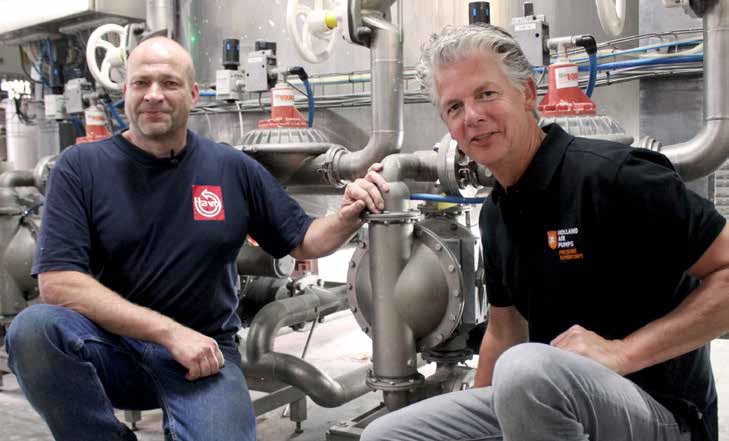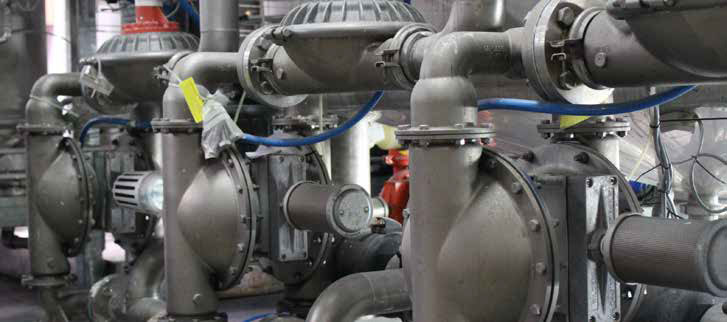When Dutch arts and crafts paint manufacturer Havo ran into problems with its pumps, switching to Wilden products enabled it to maintain the quality that its customers demand, says Alberto Lerussi, Director of Sales — EMEA for Wilden and PSG
As it turns out, there is a definite ‘art’ to the manufacture of the arts and crafts paints that enables a child to finger paint a family portrait worthy of a place on the fridge door. One company that has moved to the head of the class in the production of school and hobby paints is Dutch company Havo.
Jaap Vos founded Havo in 1963 as a manufacturer of modelling materials for use in schools in the region. In the ensuing 53 years, Havo has grown to be a leading name in the production of creative materials — paints, clay, glues, drawing materials and other related accessories — for use in the educational and retail hobby market segments.
Today, Havo’s Creall paint brand is used by schools and hobby enthusiasts in 53 countries all over the world, with further expansion into the global retail marketplace ongoing.
“We do create a lot of products, and in paints we produce 4 million litres a year,” explains Jan Zwiers, managing director for Havo. “It’s very important that we have products that have good quality and reliability, so the equipment we use to make our products needs to be efficient and effective.”
Zwiers’ commitment to only producing creative products of the highest quality not only reflects well on the Havo name, but also helps ensure domestic tranquility because he is married to Annemieke Zwiers-Vos, who is also a managing director for the company and the daughter of Havo founder Jaap Vos.

Havo, producer of creative materials for use in the educational and retail hobby markets, was recommended to use Wilden’s Original and Advanced AODD pumps by pump distributor Holland Air Pumps
Searching for the perfect pump
Seeing hobby paints dispensed from a squeeze tube or bottle gives the impression that they must be easy to manufacture. In reality, though, there are many strict mixing, blending and transferring stages that must be successfully completed for every batch to guarantee that every colour, whether primary, secondary or tertiary, has the tint and look that is expected.
“Our products look ordinary and easy to handle, but at times it’s hard to produce or pump the paints because they can be hard to manage,” says Zwiers. “Because we are in a niche market, the machines we use to produce our paints may need to be modified to make them right for our purposes. That’s why we have high demands for our machines, and that’s why we need good machines.”
The man charged with the task of ensuring that every drop of Creall paint that leaves the manufacturing plant meets Havo’s high quality standards is technical manager Job Doppenberg.
“We work from 8 a.m. to 4.30 p.m. every day, and if it’s busy, the plant keeps going until 9 p.m.,” says Doppenberg. “My job is to guarantee that all the machines are running, and if they are not running well, I look for the solution.”
Keeping equipment running properly is often easier said than done because the raw materials that are used to produce Havo’s paints can have a long list of unique handling characteristics. This can be especially true at high-volume production rates, with Havo producing a total of 3.5 million tubes and bottles of paint annually, or nearly 10,000 a day.
“We pump the paint to one big tank, mix it with pigment, then fill the bottles that go to schools or retail outlets,” Doppenberg continues. “The paints we produce are abrasive, have high viscosity and can be a little bit sticky, with some paints more sticky than others. The viscosity of our paint is also very high, up to 30,000 kilopascals (kPa), which can have more handling problems than paint with a viscosity of 20,000 kPa. So, if we have a pump problem then the different lines can’t be filled and production stops.”
Over the years, Doppenberg and Havo had tried different pump technologies, most recently gear pumps, for the hypercritical blending, mixing and bottle-filling operations, but had begun to notice shortcomings in their operational ability that were hampering the production schedules.
“We have tried a lot of different pump technologies to pump our paint, pumps with seals, and very high-priced, expensive pumps, like gear pumps,” recalls Doppenberg. “We had a gear pump running for one year and it needed to be repaired, and it never pumped good again. We also had a piston pump on our high-pressure filter press that is used for cleaning the machines and it was breaking down. So, what do you do then? We started to look for another pump.”

Creall paint is used by schools and hobby enthusiasts in more than 53 countries worldwide
Solving the problem with air
To help with the problem, Doppenberg turned to Holland Air Pumps of Oirschot in the Netherlands, a distributor of air-powered pumps, and asked Gerrit Klaassen, Holland Air Pumps’ commercial director, if he could recommend any alternatives.
“We’ve been working with Holland Air Pumps for 15 to 16 years because the service is good. They have parts in stock and, if there is a problem, the people from Holland Air Pumps come here and explain what the solution is,” says Doppenberg.
“They also supply test pumps to show what the solution is, so I talked to Gerrit and he said we could test some air pumps that they had.”
Klaassen recommended Wilden air-operated double-diaphragm (AODD) pumps, a product brand of US company PSG, for which Holland Air Pumps is a distributor in the Netherlands and other European countries.
In particular, Klaassen suggested stainless-steel Wilden Original (clamped) and Advanced (bolted) AODD pumps, the 51mm PS8 and PS800 models, respectively.
“Since the viscosity of our paints is very high we needed AODD pumps with stainless-steel balls so that the ball would not get stuck in the paint when it was time to reseat in the valve,” explains Doppenberg.
“If the ball gets stuck in the paint, it stays up and the pump won’t pump. With the stainless-steel Wilden pumps, the balls have time to drop through the paint and reseat after pumping. It’s a nice pump, a very good pump.”
In addition to having the ability to handle high-viscosity liquids, the PS8 and PS800 pumps have a redesigned liquid path that reduces internal friction for maximised flow rates and pumping efficiency with leak-free product containment guaranteed.
Diaphragm options include Buna-N, EPDM, Geolast, Neoprene, polyurethane, PTFE (Teflon), Saniflex (Hytrel), Viton and Wil-Flex (Santoprene).
Additionally, the PS8 and PS800 pumps are fitted with Wilden’s revolutionary Pro-Flo SHIFT Air Distribution System (ADS). The design and operation of the Pro-Flo SHIFT provides up to 60% savings in air consumption when compared to competitive models, achieving lower operating costs and carbon footprint. This was another crucial consideration for Havo, which prides itself on being a ‘green’ company and powers its facility with solar energy while constantly monitoring electricity consumption.
Havo employs a total of 25 Wilden pumps in its production operation, all equipped with Wilden Equalizer SD series surge dampeners. This accessory minimises unwanted pressure fluctuations during liquid-transfer applications by providing a supplementary pumping action that virtually eliminates pressure variations that can create pulse in the liquid flow, with operational capability up to 8.6 bar (125 psi).
The SD series is available in aluminum, stainless steel, cast iron and polypropylene, depending on the pump model being used, and is also compatible with all of Wilden’s standard diaphragm options.
In the filter press that is used to clean the wastewater before it moves to the treatment plant, Havo is utilising an Advanced H800 high pressure AODD pump. The bolted configuration of the 51mm pump ensures total product containment with stainless steel and cast iron available for the wetted path, which has been redesigned to maximise output and efficiency. Diaphragm options include PTFE and Wil-Flex.
“When a long-time partner like Havo comes to us with a problem, we do our best to identify and recommend the right solution,” says Klaassen. “When Job approached me with the challenge he was facing in pumping highly viscous and sticky paint products, I knew the Wilden pumps would be the best solution.”
Pumps make life easier
By their nature, artists are perfectionists, and they feel that every painting is truly a work of art. That means that the companies that produce the paints they use must also strive to provide perfect products. Havo has been able to meet that standard for more than 50 years in part by partnering with equipment suppliers that recognize its unique production needs and are able to deliver the ideal solution.
“I need machines that I can trust to do the job, and we need partners that I can trust, that if I call them they can tell me what to do, and I get that from Holland Air Pumps,” says Doppenberg. “The Wilden pumps are very good at helping me do my job, and they make my job easier.”
www.wildenpump.com

Original and Advanced AODD pumps are ideal for Havo because they can handle high-viscosity liquids
European Patent Office upholds zinc pyrithione patent
The European Patent Office (EPO) has upheld patent EP 0963291 B1, which is owned by Lonza Group.
The EPO’s decision can be appealed. Subject to the outcome of an appeal the patent will remain in force until 3 February 2018. Lonza Group has pioneered the use of zinc pyrithione in architectural paints during the last 10 years based, in part, on this patented technology.
Zinc pyrithione compounds are increasingly used to protect the surfaces of paints, coatings and other dry films from fungal and algal growth. Lonza’s Zinc Omadine Zoe dispersion, a zinc pyrithione-based product, is increasingly used as a replacement for carbendazim-based products that need to carry enhanced environmental warnings on their labels at normal use levels because of toxicological concerns expressed by regulatory bodies in certain markets.